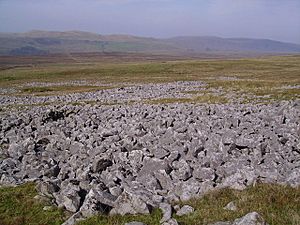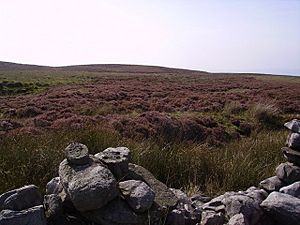Leck Fell facts for kids
| Site of Special Scientific Interest | |
 |
|
| Area of Search | Cumbria, Lancashire |
|---|---|
| Interest | Geological |
| Area | 703.1 hectares (1,737 acres) |
| Notification | 1959 |
| Location map | English Nature |
Leck Fell is a special area in Lancashire, England. It's known for its wide-open moorland, which is mostly covered in rough grass and some patches of heather. There aren't many trees here.
What makes Leck Fell unique is how water moves through it. You won't see many streams on the surface. Instead, water goes underground into a huge network of caves and holes called sinkholes. This area is located around Gragareth, a high point that is 627 metres (2,057 ft) tall. It sits between Leck Beck and Kingsdale.
Since August 1, 2016, Leck Fell has been part of the beautiful Yorkshire Dales National Park.
Contents
What Makes Leck Fell Special?
Leck Fell is a Site of Special Scientific Interest (SSSI). This means it's a protected area because of its unique natural features. It has an amazing network of cave systems.
Britain's Longest Cave System
One of the most exciting parts of Leck Fell is Ease Gill Caverns. This is the longest cave system in all of Britain! Imagine exploring tunnels that stretch for miles underground.
Water from the surface enters these caves through fourteen large sinkholes. A sinkhole is like a giant funnel in the ground where water disappears. After traveling through the caves, the water comes back to the surface at a place called Leck Beck Head.
Limestone Landscape
The ground beneath Leck Fell is made of Carboniferous Limestone. This type of rock creates cool features you can see above ground. These include tall cliffs called crags, flat rocky areas known as limestone pavements, deep valleys called gorges, and potholes.
Long ago, during the Bronze Age, this area had more trees. But animals grazing and changes in the weather led to the trees disappearing. This also helped create thick layers of peat, which is decayed plant matter. Today, you'll see many long, straight stone walls across the landscape. These were built in the late 1700s or 1800s to divide the land.
Amazing Plants of Leck Fell
Leck Fell is home to many interesting plants, especially ferns. The limestone cliffs at Easegill support special ferns like rigid buckler fern, limestone polypody, and mossy saxifrage.
Downstream from Easegill, there's a steep, wooded gorge. Here, you can find eleven different types of ferns! Other plants like wood forget-me-not, hairy rock-cress, wall lettuce, sanicle, and whitlow grass also grow here.
In contrast, some areas have more acidic rock. These spots support plants like wood rush, hard fern, and beech fern. The steep slopes around some potholes also have plants similar to those found in woodlands.
Plants in Limestone Pavements
You'll also find limestone pavements. These are flat areas of rock with deep cracks and fissures. Inside these cracks, ferns and a unique small shrub called baneberry grow. They are safe from grazing sheep because they are hidden in the cracks.
Exploring the Cave Systems
The Three Counties System is a massive network of caves that stretches for 87-kilometre (54 mi) (about 54 miles)! It goes from Kingsdale to Barbondale and includes several important cave systems right under Leck Fell.
Some of the famous caves in this system include:
- Death's Head Hole
- Long Drop Cave
- Lost Johns' Cave
- Notts Pot
- Rumbling Hole
- Short Drop Cave - Gavel Pot System
If you want to explore most of these caves, you usually need to get a special permit first. This helps keep the caves safe and protected.


